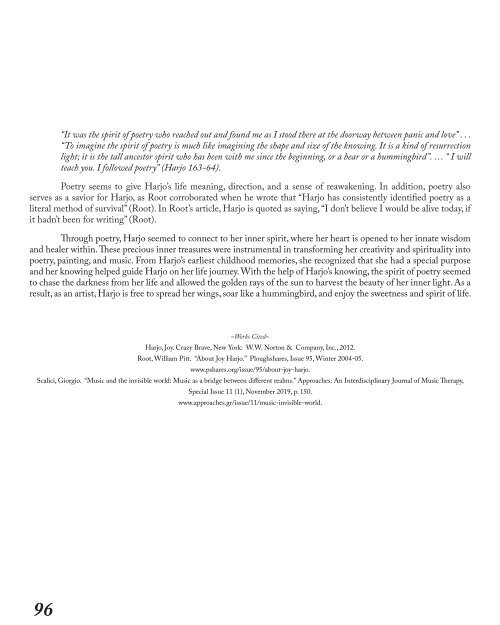SandScript 2022
Art & Literature Magazine
Art & Literature Magazine
Create successful ePaper yourself
Turn your PDF publications into a flip-book with our unique Google optimized e-Paper software.
One Example of the Hazy History of<br />
the United States’ Drug Policy<br />
Collin Bryant<br />
96<br />
“It was the spirit of poetry who reached out and found me as I stood there at the doorway between panic and love” . . .<br />
“To imagine the spirit of poetry is much like imagining the shape and size of the knowing. It is a kind of resurrection<br />
light; it is the tall ancestor spirit who has been with me since the beginning, or a bear or a hummingbird”. … “ I will<br />
teach you. I followed poetry” (Harjo 163-64).<br />
Poetry seems to give Harjo’s life meaning, direction, and a sense of reawakening. In addition, poetry also<br />
serves as a savior for Harjo, as Root corroborated when he wrote that “Harjo has consistently identified poetry as a<br />
literal method of survival” (Root). In Root’s article, Harjo is quoted as saying, “I don’t believe I would be alive today, if<br />
it hadn’t been for writing” (Root).<br />
Through poetry, Harjo seemed to connect to her inner spirit, where her heart is opened to her innate wisdom<br />
and healer within. These precious inner treasures were instrumental in transforming her creativity and spirituality into<br />
poetry, painting, and music. From Harjo’s earliest childhood memories, she recognized that she had a special purpose<br />
and her knowing helped guide Harjo on her life journey. With the help of Harjo’s knowing, the spirit of poetry seemed<br />
to chase the darkness from her life and allowed the golden rays of the sun to harvest the beauty of her inner light. As a<br />
result, as an artist, Harjo is free to spread her wings, soar like a hummingbird, and enjoy the sweetness and spirit of life.<br />
~Works Cited~<br />
Harjo, Joy. Crazy Brave, New York: W.W. Norton & Company, Inc., 2012.<br />
Root, William Pitt. “About Joy Harjo.” Ploughshares, Issue 95, Winter 2004-05.<br />
www.pshares.org/issue/95/about-joy-harjo.<br />
Scalici, Giorgio. “Music and the invisible world: Music as a bridge between different realms.” Approaches: An Interdisciplinary Journal of Music Therapy,<br />
Special Issue 11 (1), November 2019, p. 150.<br />
www.approaches.gr/issue/11/music-invisible-world.<br />
Last semester, I wrote an essay about the unjust and oppressive history of the United States’ drug policy.<br />
The essay touched on history from the very beginning of the war on drugs, with opium laws being used to target<br />
Asian American immigrants during the early 20 th century, to more contemporary policies such as the crack versus<br />
powder sentencing disparity which targeted black crack cocaine users. There is a fair amount of scholarly literature<br />
surrounding these topics, so I felt confident that they supported my claim—that the United States has used their<br />
drug policy not to protect people, but rather to oppress them—quite well. However, in the essay, I cited an obscure<br />
piece of drug policy that doesn’t have as much scholarly literature and criticism surrounding it, the Marihuana Tax<br />
Act of 1937. I cited this act as one which targeted Mexican American immigrants in the southwest who, like Asian<br />
Americans with opium, brought over and spread the use of cannabis. Although this obscure piece of drug policy<br />
history was only mentioned in passing in my essay, it still bothered me that it was not concrete or empirical evidence<br />
that supported the main claim. Now, since the Intercultural Perspectives class has been studying Mexican American<br />
history, it is a good time to answer a question I’ve had for a while: Was the Marihuana Tax Act of 1937 meant to<br />
oppress Mexican Americans in the Southwest? To answer this question, first the act itself must be defined, explored,<br />
and laid out. Then, the factors that contributed to the passage of this act must be looked at. Finally, historical trends<br />
in drug use should be examined and subsequently, how the drugs became available should be looked at as well.<br />
Technically a revenue raising act, The Marihuana Tax Act of 1937 did not make cannabis illegal. Instead,<br />
it imposed taxes on growers, medical professionals, and importers. Importers had a particularly extreme tax (Padwa<br />
and Cunningham 569). Additionally, by federal law, anyone who grew, transported, prescribed, or sold the drug<br />
needed to register their product to pay the tax. But, since many state governments made cannabis illegal prior to<br />
1937, doing so would be an act of self-incrimination. Overall, even though the act did not make cannabis illegal,<br />
it did place regulations so tight that effectively nobody could use it legally. Oddly enough, the Federal Bureau of<br />
Narcotics, or FBN for short (the predecessor agency of the Drug Enforcement Administration, or DEA), did not<br />
seem to give much mind to cannabis use at first. In fact, according to the article “Marihuana Tax Act,” the FBN “at<br />
first doubted the constitutionality of proposed federal laws for marijuana control, and feared that marijuana laws<br />
would be difficult to enforce” due to how easily the plant could be grown on American soil in comparison to opium<br />
and coca plants (Padwa and Cunningham 569). However, in the mid-1930s, pressure from local police forces in<br />
the southwestern U.S. and pleas from state-level officials led to an all-out anti-marijuana campaign led by Henry J.<br />
Anslinger, the head of the FBN at the time (Kinder, Douglas C. and Walker III, William O. 909). In October 1937,<br />
the act passed despite resistance from medical professionals who believed the control of cannabis was unjust and<br />
unnecessary.<br />
During the 1910s and 1920s, there was a somewhat common association of cannabis with Mexicans in<br />
the United States. During the 1930s, this trend became more popular (Griffin III, O.Hayde., et al 772). Mexican<br />
immigrants were willing to work for extremely low wages compared to their Anglo counterparts, which led to a<br />
dramatic increase in the competition for jobs. Cannabis use was not widely accepted, even by Mexican Americans,<br />
but their association with the drug was already stereotypical—due in part to the all-out anti-marijuana campaign<br />
waged by the FBN some years earlier. Cannabis use, whether real or imagined, was seen as a justification by<br />
employers to favor white workers over Mexican laborers when it came to employment during the Great Depression.<br />
It was used as a scapegoat—protection against employers so they wouldn’t come off as explicitly racist. Because<br />
Mexican people themselves were stigmatized and “feared as a source of crime and deviant social behavior,” in turn<br />
cannabis was viewed this way too (Campos 10). Also adding to the public fear of cannabis was the propaganda film<br />
Reefer Madness, a public health and safety video alarming people of the dangers of “marihuana addiction.” Despite<br />
its own admittedly fictional content, the film had a great impact on the public perception of cannabis nationwide.<br />
It’s a matter of debate whether or not Mexicans immigrating to the United States popularized cannabis.<br />
Mexico was regulating cannabis well over a decade before the United States passed The Marihuana Tax Act. In<br />
1920, Mexico banned the sale, production, and recreational use of cannabis and in 1927 banned its export as well.<br />
Perhaps this contributed to the migration of Mexicans northwards, where there weren’t any prohibitionist laws<br />
surrounding the plant. However, a recent scholarly article analyzing Mexican immigrants’ role in the passage<br />
97<br />
...




![SandScript 2023 [Digital Exclusive]](https://img.yumpu.com/68282062/1/190x238/sandscript-2023-digital-exclusive.jpg?quality=85)

